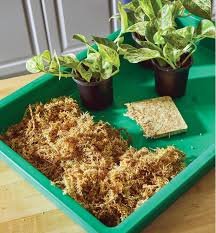What is Sphagnum Moss?
Sphagnum moss, often referred to simply as “peat moss,” is one of nature’s most remarkable plants. Found primarily in wetland areas, it serves a multitude of ecological and practical purposes. This versatile moss has played a crucial role in ecosystems for millennia, and its uses extend far beyond nature. Today, sphagnum moss is a valuable commodity in various industries, ranging from horticulture and gardening to traditional medicine.
Sphagnum moss is a genus of mosses that thrive in boggy, waterlogged environments, often forming large, dense mats across the ground. Unlike other types of moss, sphagnum has a unique ability to absorb and retain an exceptional amount of water, which helps create the wet, acidic conditions typical of peat bogs. There are over 120 species of this, and they are found all over the world, with the majority growing in cool, temperate regions.
What sets sphagnum moss apart from other mosses is its structure. The plant is composed of tiny, soft leaves that retain water, which makes it highly absorbent and capable of storing moisture for long periods. This grows by producing new branches at the tips while the older parts of the plant die off, eventually forming peat. This process is slow, with some bogs containing layers of peat that have accumulated over thousands of years.
The Role of Sphagnum Moss in Nature
Sphagnum moss plays a vital role in the natural world, especially in wetland ecosystems. Its most important function is its ability to retain large amounts of water. Sphagnum can hold up to 20 times its weight in water, which helps maintain moisture levels in bogs and wetlands. This is crucial for the plants and animals that depend on these habitats.
Moreover, it is a primary contributor to the formation of peat bogs. As it decomposes slowly in the acidic, waterlogged conditions of bogs, its creates peat – a dense, organic material that accumulates over time. Peat bogs are significant for two reasons: they store vast amounts of carbon, helping mitigate climate change, and they provide critical habitats for a variety of species, including rare plants and birds.
Another lesser-known ecological benefit of sphagnum moss is its ability to acidify the soil and water around it. The decomposition of sphagnum releases organic acids that lower the pH of the surrounding environment, making it inhospitable to many types of bacteria and fungi. This creates a unique ecosystem where only specialized plants can thrive, further contributing to biodiversity.
Uses of Sphagnum Moss
Sphagnum moss has a broad range of uses across various sectors, most notably in horticulture and gardening. Its ability to hold moisture, improve soil quality, and support plant growth makes it a valuable resource for gardeners and plant enthusiasts worldwide.
In horticulture, this is often used as a growing medium, particularly for plants like orchids, carnivorous plants, and succulents, which thrive in well-drained, moisture-retaining environments. Sphagnum is commonly found in potting mixes, where it helps maintain a stable moisture level, preventing the roots from drying out. It also promotes healthy root growth by improving aeration in the soil.
Beyond its role in plant care, it has applications in the decorative side of gardening. It is often used as mulch in flower beds to retain moisture and suppress weeds. Its ability to hold water makes it ideal for container gardening, as it reduces the frequency of watering. Additionally, it is frequently used in floral arrangements, particularly for creating a natural, earthy aesthetic.
Historically, it was used as a wound dressing during wartime due to its absorbent and antiseptic properties. It was particularly useful for soldiers in World War I and World War II, as it could be easily gathered and applied to stop bleeding or prevent infection in wounds. The antibacterial properties of sphagnum moss are due to its high content of phenolic compounds, which inhibit the growth of bacteria and fungi.
Another industry that relies on sphagnum moss is the pet care industry. Sphagnum moss is used in terrariums and vivariums to maintain humidity levels for reptiles and amphibians. These creatures thrive in moist environments, and it provides the ideal substrate to recreate their natural habitats. The moss also helps maintain temperature stability in these controlled environments.
How to Harvest and Care for Sphagnum Moss
Harvesting sphagnum moss is an environmentally sensitive process. While it is widely available in many parts of the world, over-harvesting can damage ecosystems and lead to the depletion of peat bogs. Sustainable harvesting practices are essential to ensure the continued health of sphagnum moss populations and the ecosystems they support.
In order to harvest it sustainably, it’s important to take only a small portion of the moss at a time and allow the remaining moss to regenerate. Most commercial harvesting involves carefully collecting the moss from the surface of peat bogs without disturbing the underlying peat layers. In some cases, moss is harvested by hand to minimize environmental impact.
Once harvested, it can be dried and stored for future use. It should be kept in a cool, dry place to prevent mold growth. If you are using this in a gardening context, it should be rehydrated before use. This can be done by soaking the moss in water for several hours to restore its moisture-retaining properties.
Sphagnum Moss vs. Other Types of Moss
When compared to other types of moss, sphagnum moss stands out due to its exceptional water-holding capacity and the role it plays in peat bogs. While other mosses, such as sheet moss and cushion moss, are commonly used in gardening and landscaping, this is particularly valued for its ability to retain moisture and improve soil quality.
Sheet moss is a low-growing moss that is often used for decorative purposes in gardens or as ground cover, but it does not have the same water retention capabilities as sphagnum moss. Cushion moss, on the other hand, is thicker and more compact, making it ideal for creating moss balls or topiary. However, it remains the preferred choice for growing plants that require high moisture levels, such as orchids and carnivorous plants.
Environmental Impact and Sustainability
The environmental impact of sphagnum moss harvesting is a critical issue, particularly in areas where peat bogs are being depleted at unsustainable rates. Peat bogs are slow-growing ecosystems, and once they are disturbed, it can take centuries for them to regenerate. As such, it’s crucial to prioritize sustainable harvesting practices to ensure that the ecological balance is maintained.
One solution to the environmental concerns surrounding sphagnum moss harvesting is the development of alternative materials and eco-friendly methods. Some companies have started offering alternatives to harvested moss, such as synthetic moss or moss harvested from renewable sources. These alternatives can help reduce the pressure on natural sphagnum moss populations while still providing the benefits that the moss offers.
How to Grow Sphagnum Moss
Growing sphagnum moss at home can be a rewarding experience, especially for those who enjoy creating terrariums or working with plants that require high humidity levels. To grow this, you need to provide it with the right conditions. The moss thrives in environments that are consistently moist and receive indirect light. A sealed container or terrarium is an ideal environment, as it creates a humid atmosphere that is perfect for sphagnum growth.
To propagate this you can start by collecting small portions of moss from a local area or purchasing it from a garden center. Simply place the moss in a container with a substrate such as peat or sand and mist it regularly to maintain moisture levels. Over time, the moss will spread and grow, creating a lush, green mat.
Common Myths and Misunderstandings about Sphagnum Moss
There are a few myths and misconceptions about sphagnum moss that are worth addressing. One common misunderstanding is that sphagnum is difficult to care for. In reality, it is relatively low-maintenance and can thrive in a variety of conditions as long as it is kept moist. Another misconception is that sphagnum moss is harmful to plants. On the contrary, it is an excellent growing medium for many plant species, especially those that require high humidity and moisture.
Another myth is that sphagnum moss is harmful to the environment. While unsustainable harvesting practices can cause damage to ecosystems, it itself is a vital part of many wetland environments and contributes to carbon sequestration and biodiversity.
Conclusion
Sphagnum moss is a fascinating and valuable plant with a wide range of uses and ecological benefits. From its role in maintaining wetland ecosystems to its applications in gardening, horticulture, and even pet care, sphagnum moss continues to prove its versatility and importance. However, as with any natural resource, it is essential to ensure sustainable harvesting practices to protect the ecosystems that rely on this remarkable plant. By understanding its significance and treating it with care, we can continue to enjoy the many benefits of sphagnum moss for generations to come.


